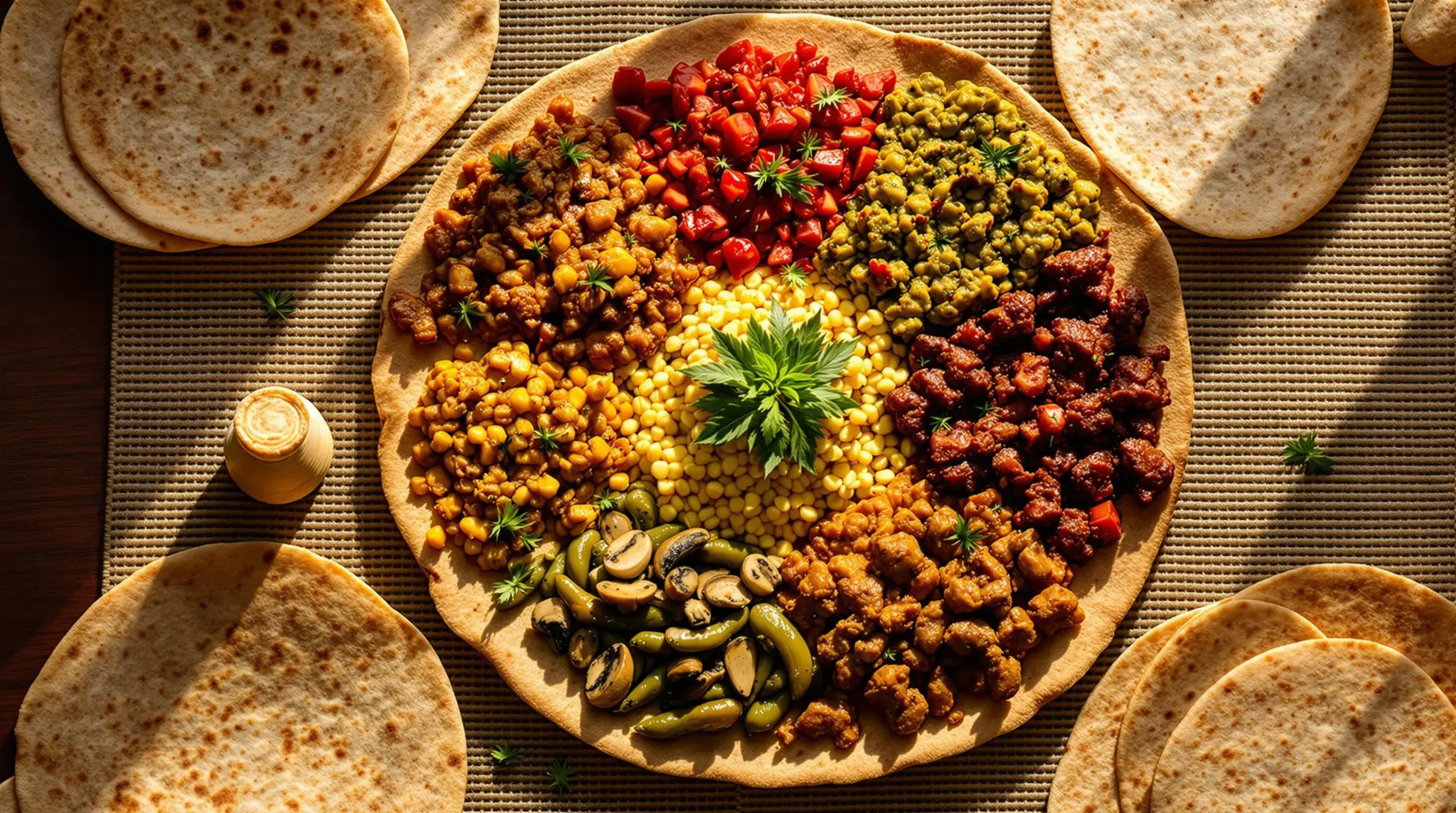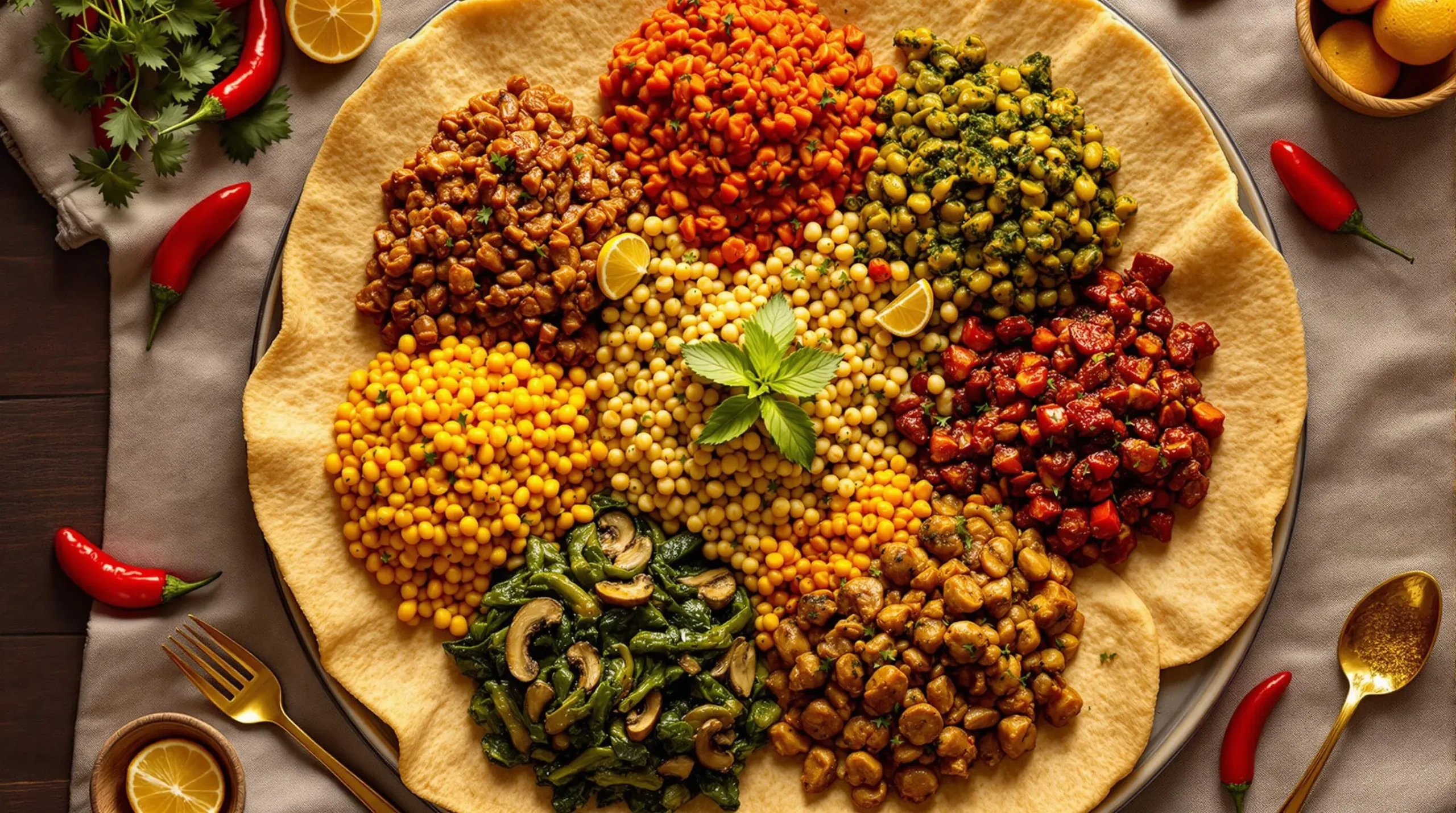Traditional Vegan Ethiopian Recipes
Ethiopian cuisine offers a treasure trove of vibrant vegan Ethiopian recipes that have been cherished for generations. In fact, many traditional Ethiopian dishes are naturally plant-based, thanks to the country’s rich history of Orthodox Christian fasting periods where meat and dairy are avoided.
When exploring vegan Ethiopian recipes, you’ll discover a world of bold flavors centered around aromatic spice blends like berbere and mitmita. These distinctive seasonings transform simple ingredients like lentils, split peas, and vegetables into extraordinary dishes. Moreover, the traditional injera flatbread, made from fermented teff flour, serves as both a foundation and eating utensil for these flavorful creations.
Essential Vegan Ethiopian Recipes to Try
In Ethiopian cooking, protein-packed legumes and hearty vegetables take center stage, making these dishes both satisfying and delicious. From the earthy misir wat (spiced red lentils) to the savory gomen (sautéed collard greens), each recipe showcases the cuisine’s masterful blend of spices and techniques. Additionally, the communal dining style, where multiple dishes are served on a single platter of injera, creates an engaging and social dining experience.
Whether you’re new to Ethiopian cuisine or looking to expand your plant-based cooking repertoire, these time-honored recipes offer endless possibilities for creative, flavorful meals. Let’s dive into the essential spice blends and cooking techniques that form the backbone of Ethiopian vegan cooking.
Essential Ethiopian Spices and Ingredients
The foundation of vegan Ethiopian recipes lies in its distinctive spice blends and carefully selected ingredients. These fundamental components transform simple plant-based ingredients into complex, flavorful dishes that have delighted generations of families across Ethiopia.
Berbere Spice Blend
At the heart of many vegan Ethiopian recipes sits berbere, a complex spice mixture that adds depth and warmth to dishes. This vibrant red blend typically includes:
- Ground dried chilies
- Paprika
- Fenugreek
- Coriander
- Cardamom
- Cinnamon
- Cloves
- Black pepper
To make berbere at home, start by toasting whole spices until fragrant, then grind them together with dried chilies. The heat level can be adjusted by varying the ratio of mild to hot chilies. For best results, store your freshly made berbere in an airtight container away from direct sunlight, where it will keep its potency for up to six months.

Niter Kibbeh (Spiced Oil)
Traditional Ethiopian cooking relies heavily on niter kibbeh, a spiced clarified butter. However, for vegan Ethiopian recipes, a plant-based version using coconut oil or refined olive oil creates an equally aromatic base. To prepare vegan niter kibbeh:
- Heat your chosen oil over low heat
- Add whole spices like cardamom, cinnamon, cumin, and fenugreek
- Incorporate aromatic vegetables such as onion, garlic, and ginger
- Simmer gently for 30-45 minutes
- Strain and store for future use
This flavored oil adds richness and complexity to stews, known as wats, and other traditional dishes.
Common Base Ingredients
Most Ethiopian dishes start with a foundation of everyday ingredients that, when combined, create extraordinary flavors. These essential components include:
- Red onions – Forms the base of many dishes, often cooked until caramelized
- Garlic and ginger – Fresh and aromatic, used generously in most recipes
- Tomatoes – Both fresh and paste add depth and color
- Lentils – Red, brown, and split peas feature prominently
- Mushrooms – Often used to add meaty texture in plant-based versions
These ingredients work together harmoniously in Ethiopian cuisine, creating layers of flavor that develop throughout the cooking process. Furthermore, the technique of slow cooking these base ingredients allows their flavors to meld and intensify.
When shopping for these ingredients, local Ethiopian markets often offer the best selection of authentic spices and legumes. Additionally, many specialty grocery stores now stock essential Ethiopian ingredients, making it easier than ever to create authentic dishes at home.
Understanding these fundamental components and how they work together is crucial for mastering Ethiopian cooking. Moreover, having these basics on hand means you’ll always be ready to create satisfying plant-based meals that capture the essence of Ethiopian cuisine.
Classic Ethiopian Vegan Recipes
Building on the essential spices and ingredients, these beloved vegan Ethiopian recipes showcase the cuisine’s remarkable ability to create deeply satisfying plant-based dishes. Each recipe demonstrates how simple ingredients transform into complex, flavorful meals through careful preparation and expert spicing.
Misir Wot (Red Lentil Stew)
Misir wot stands as one of the most popular vegan Ethiopian recipes, combining red lentils with aromatic spices into a creamy, comforting stew. To create this dish:
- 2 cups red lentils, rinsed
- 1 large red onion, finely diced
- 4-5 cloves garlic, minced
- 2-3 tablespoons berbere
- Vegan niter kibbeh
Start by sautéing onions in the spiced oil until golden brown. Next, add garlic and berbere, stirring until fragrant. Then, incorporate the lentils and water, simmering until they break down into a thick, smooth consistency. For the most authentic results, cook the lentils until they’re completely soft, usually about 30-40 minutes.
Mushroom Tibs
This clever adaptation of the traditional meat dish creates a satisfying plant-based version using mushrooms. The key to perfect mushroom tibs lies in achieving a slightly crispy exterior while maintaining a juicy interior. Ingredients include:
- Mixed mushrooms (portobello, cremini)
- Red onions and bell peppers
- Mitmita or berbere spice
- Fresh rosemary and thyme
First, cut mushrooms into bite-sized pieces. Then, sauté them in small batches to ensure proper browning. Finally, combine with sautéed vegetables and spices for a delicious main course that pairs perfectly with injera.
Shiro Wot
Shiro wot, another staple among vegan Ethiopian recipes, uses seasoned chickpea flour as its base. This smooth, gravy-like dish offers incredible depth of flavor:
- Heat spiced oil in a heavy pot
- Add minced onions and garlic
- Stir in chickpea flour gradually
- Simmer while stirring constantly
- Add water until desired consistency
The texture should be similar to thick gravy – not too runny or too firm. Moreover, constant stirring prevents lumps from forming during cooking. For best results, let the shiro rest briefly before serving to allow flavors to meld.
These classic dishes form the cornerstone of Ethiopian vegan cuisine, each offering unique textures and flavors. Furthermore, they can be served individually or, more traditionally, as part of a larger spread on injera bread. Additionally, these recipes work well for meal prep, often tasting even better the next day as flavors continue to develop.
When preparing these dishes, remember that patience is key – Ethiopian cooking celebrates slow, careful preparation that allows spices to bloom and flavors to deepen. Besides, these recipes offer excellent starting points for exploring the broader world of Ethiopian plant-based cooking.
Serving and Accompaniments for Vegan Ethiopian Recipes
The art of serving vegan Ethiopian recipes extends beyond just cooking the dishes. Traditional Ethiopian meals create a communal dining experience where multiple dishes are thoughtfully arranged on a base of injera bread, encouraging sharing and connection around the table.
Making Perfect Injera
The cornerstone of vegan Ethiopian recipes, injera is a sourdough flatbread with a unique spongy texture. While traditionally made with teff flour, modern adaptations offer several options:
- Pure teff flour (most authentic)
- Teff-wheat flour blend (easier to work with)
- Gluten-free alternatives using sorghum or buckwheat
To make traditional injera:
- Mix teff flour with water
- Let ferment for 2-3 days
- Add fresh water to thin the batter
- Cook on a flat griddle in a spiral pattern
For beginners, starting with a teff flour blend often yields more consistent results. Additionally, many Ethiopian markets now offer pre-fermented injera batter, making home preparation more accessible.
Essential Side Dishes
No Ethiopian feast is complete without colorful side dishes that complement the main courses. Popular accompaniments include:
- Atakilt wat – Cabbage, carrots, and potatoes seasoned with turmeric
- Kik alicha – Yellow split peas simmered with garlic and ginger
- Fosolia – Green beans and carrots in a light sauce
- Fresh tomato salad with jalapeños
- Sautéed mushrooms with berbere
These sides add variety in texture and flavor, creating a balanced meal. Moreover, they offer lighter options to contrast with heartier main dishes. Furthermore, many of these sides can be prepared in advance, making meal planning easier.

Traditional Serving Style
The presentation of vegan Ethiopian recipes follows a distinct serving style that enhances the dining experience:
- Layer large injera on a round platter
- Arrange main dishes in small mounds around the edge
- Place colorful side dishes in between
- Add rolled injera on the side
- Garnish with fresh chilies and lemon wedges
For modern adaptations, consider:
- Individual plates for casual dining
- Family-style platters for gatherings
- Deconstructed versions for food service
- Meal prep containers for weekly planning
When planning portions, estimate about two cups of various dishes per person. Besides, include a mix of spicy and mild options to accommodate different preferences. Additionally, serve extra injera on the side, as it tends to disappear quickly.
The key to successful Ethiopian meal presentation lies in the balance of colors, textures, and flavors. Therefore, arrange dishes thoughtfully, considering both visual appeal and practical access for diners. Besides, traditional Ethiopian dining encourages using the right hand to eat, though providing utensils for guests more comfortable with Western dining customs is perfectly acceptable.
Frequently Asked Questions About Vegan Ethiopian Recipes
After exploring these vegan Ethiopian recipes, you might have some questions about preparation, ingredients, and serving suggestions. Here are answers to common questions that will help you create authentic Ethiopian dishes at home.
Can I reduce the spiciness while maintaining authenticity?
Absolutely! When making vegan Ethiopian recipes, you can adjust the heat level by:
- Starting with half the recommended berbere amount
- Adding more gradually to taste
- Using sweet paprika instead of hot chilies
- Including extra tomato paste to balance heat
- Serving cooling sides like fresh tomato salad
Where can I find Ethiopian ingredients?
While specialty ingredients are becoming more widely available, here’s where to look:
- Ethiopian or African grocery stores
- International markets
- Online specialty retailers
- Natural food stores
- Regular supermarkets’ international aisles
Additionally, you can substitute regular ingredients:
- Ground flaxseed for teff flour
- Curry powder with added paprika for berbere
- Regular onions for shallots
- Standard vegetable oil for specialty oils
How should I store homemade spice blends?
To maintain freshness of spice blends like berbere:
- Store in airtight containers
- Keep away from direct sunlight
- Place in a cool, dry location
- Use within 6 months
- Label with mixing date
Can these recipes be made in advance?
Most Ethiopian dishes actually improve with time as flavors develop. For best results:
- Cook lentil and bean dishes up to 3 days ahead
- Store in airtight containers in the refrigerator
- Reheat gently with a splash of water
- Make fresh injera just before serving
- Prepare spice blends in larger batches
Remember that practicing these recipes will help you develop an intuition for the right spice levels and cooking times. Moreover, don’t be afraid to adapt these traditional dishes to your taste while respecting their cultural origins. Furthermore, joining online Ethiopian cooking communities can provide additional support and inspiration for your culinary journey.
Bringing Vegan Ethiopian Recipes to Your Kitchen
After exploring these vibrant vegan Ethiopian recipes, you’re now equipped with the essential knowledge to create authentic plant-based Ethiopian dishes at home. The journey through Ethiopia’s rich culinary traditions reveals how simple ingredients, when combined with aromatic spice blends and time-honored techniques, transform into extraordinary meals that bring people together.
The key to success with these vegan Ethiopian recipes lies in understanding the fundamental role of spices like berbere and cooking methods that develop deep, complex flavors. Furthermore, mastering the art of making injera and properly balancing various dishes on a communal platter adds an authentic touch to your Ethiopian cooking experience.
Remember these essential tips as you begin your Ethiopian cooking journey:
- Toast whole spices before grinding to enhance their flavors
- Allow lentils and stews to simmer slowly for optimal texture
- Practice making injera – each attempt brings improvement
- Keep basic ingredients like berbere and spiced oil ready
- Experiment with heat levels to find your perfect balance
Most importantly, Ethiopian cuisine celebrates sharing and community. Therefore, don’t hesitate to gather friends and family around your homemade spread of colorful wats, fresh injera, and aromatic side dishes. Additionally, feel free to adapt these traditional recipes to your taste while maintaining their authentic spirit.
As you continue exploring Ethiopian cooking, you’ll discover that these plant-based dishes offer endless possibilities for creative interpretation. Moreover, the skills and techniques you’ve learned will enhance your overall cooking expertise, bringing new dimensions to your culinary repertoire.

Now, it’s time to head to the kitchen and start creating your own Ethiopian feast. With patience, practice, and passion, you’ll soon master these beloved recipes that have delighted generations of families across Ethiopia and beyond.

